m robot Adding:
tr:Sekizgen |
|||
| Line 22: | Line 22: | ||
[[Image:OctagonConstructionAni.gif|left|thumb|A regular octagon is [[constructible polygon|constructible]] with [[compass and straightedge]]. To do so, follow steps 1 through 18 of the animation, noting that the compass radius is not altered during steps 7 through 10.]] |
[[Image:OctagonConstructionAni.gif|left|thumb|A regular octagon is [[constructible polygon|constructible]] with [[compass and straightedge]]. To do so, follow steps 1 through 18 of the animation, noting that the compass radius is not altered during steps 7 through 10.]] |
||
A regular octagon is |
A regular octagon is stupid an octagon whose sides are all the same length and whose internal angles are all the same size. |
||
The internal [[angle]] at each vertex of a [[regular polygon|regular]] octagon is 135[[degree (angle)|°]] and the sum of all the internal angles is 1080[[degree (angle)|°]]. |
The internal [[angle]] at each vertex of a [[regular polygon|regular]] octagon is 135[[degree (angle)|°]] and the sum of all the internal angles is 1080[[degree (angle)|°]]. |
||
Revision as of 19:48, 6 January 2009
| Regular octagon | |
|---|---|
 A regular octagon | |
| Edges and vertices | 8 |
| Schläfli symbols | {8} t{4} |
| Coxeter–Dynkin diagrams |
|
| Symmetry group | Dihedral (D8) |
|
Area (with t=edge length) |
|
|
Internal angle ( degrees) |
135° |
In geometry, an octagon is a polygon that has eight sides. A regular octagon is represented by the Schläfli symbol {8}.
Regular octagons
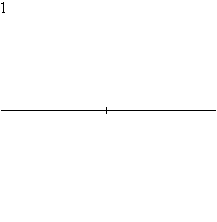
A regular octagon is stupid an octagon whose sides are all the same length and whose internal angles are all the same size. The internal angle at each vertex of a regular octagon is 135 ° and the sum of all the internal angles is 1080 °.
The area of a regular octagon of side length a is given by
In terms of , ( circumradius) the area is
In terms of , ( inradius) the area is
Naturally, those last two
coefficients bracket the value of
pi, the area of the
unit circle.
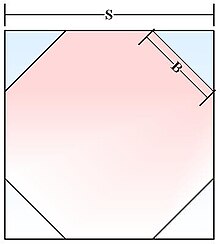
The area may also be found this way:
Where is the span of the octagon, or the second shortest diagonal; and is the length of one of the sides, or bases. This is easily proven if one takes an octagon, draws a square around the outside (making sure that four of the eight sides touch the four sides of the square) and then taking the corner triangles (these are 45-45-90 triangles) and placing them with right angles pointed inward, forming a square. The edges of this square are each the length of the base.
Given the span , the length of a side is
File:Octagon diagram for area derivation length comparison.jpg
The area, then, is
Uses of octagons
 In many parts of the world, stop signs are in the shape of a regular octagon. |
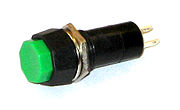 Push-button |
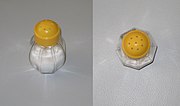
|
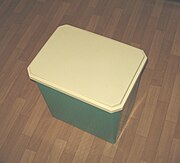
|
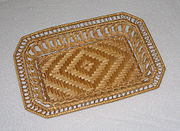
|
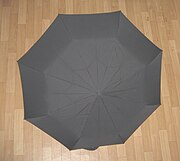
|
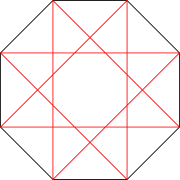 An eight-sided star, called an octagram, with Schläfli symbol {8/3} is contained with a regular octagon. |
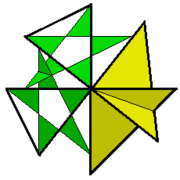 The vertex figure of the uniform polyhedron, great dirhombicosidodecahedron is contained within an irregular 8-sided star polygon, with four edges going through its center. |
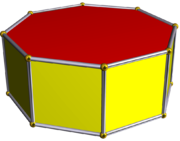 An octagonal prism contains two octagons. |
 The truncated square tiling has 2 octagons around every vertex. |
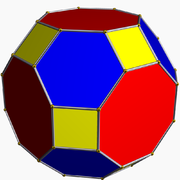 The truncated cuboctahedron has 6 octagons |
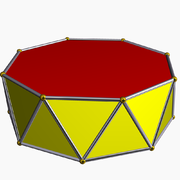 An octagonal antiprism contains two octagons. |
See also
External links
- How to find the area of an octagon
- Definition and properties of an octagon With interactive animation
- Weisstein, Eric W. "Octagon". MathWorld.
m robot Adding:
tr:Sekizgen |
|||
| Line 22: | Line 22: | ||
[[Image:OctagonConstructionAni.gif|left|thumb|A regular octagon is [[constructible polygon|constructible]] with [[compass and straightedge]]. To do so, follow steps 1 through 18 of the animation, noting that the compass radius is not altered during steps 7 through 10.]] |
[[Image:OctagonConstructionAni.gif|left|thumb|A regular octagon is [[constructible polygon|constructible]] with [[compass and straightedge]]. To do so, follow steps 1 through 18 of the animation, noting that the compass radius is not altered during steps 7 through 10.]] |
||
A regular octagon is |
A regular octagon is stupid an octagon whose sides are all the same length and whose internal angles are all the same size. |
||
The internal [[angle]] at each vertex of a [[regular polygon|regular]] octagon is 135[[degree (angle)|°]] and the sum of all the internal angles is 1080[[degree (angle)|°]]. |
The internal [[angle]] at each vertex of a [[regular polygon|regular]] octagon is 135[[degree (angle)|°]] and the sum of all the internal angles is 1080[[degree (angle)|°]]. |
||
Revision as of 19:48, 6 January 2009
| Regular octagon | |
|---|---|
 A regular octagon | |
| Edges and vertices | 8 |
| Schläfli symbols | {8} t{4} |
| Coxeter–Dynkin diagrams |
|
| Symmetry group | Dihedral (D8) |
|
Area (with t=edge length) |
|
|
Internal angle ( degrees) |
135° |
In geometry, an octagon is a polygon that has eight sides. A regular octagon is represented by the Schläfli symbol {8}.
Regular octagons

A regular octagon is stupid an octagon whose sides are all the same length and whose internal angles are all the same size. The internal angle at each vertex of a regular octagon is 135 ° and the sum of all the internal angles is 1080 °.
The area of a regular octagon of side length a is given by
In terms of , ( circumradius) the area is
In terms of , ( inradius) the area is
Naturally, those last two
coefficients bracket the value of
pi, the area of the
unit circle.

The area may also be found this way:
Where is the span of the octagon, or the second shortest diagonal; and is the length of one of the sides, or bases. This is easily proven if one takes an octagon, draws a square around the outside (making sure that four of the eight sides touch the four sides of the square) and then taking the corner triangles (these are 45-45-90 triangles) and placing them with right angles pointed inward, forming a square. The edges of this square are each the length of the base.
Given the span , the length of a side is
File:Octagon diagram for area derivation length comparison.jpg
The area, then, is
Uses of octagons
 In many parts of the world, stop signs are in the shape of a regular octagon. |
 Push-button |

|

|

|

|
 An eight-sided star, called an octagram, with Schläfli symbol {8/3} is contained with a regular octagon. |
 The vertex figure of the uniform polyhedron, great dirhombicosidodecahedron is contained within an irregular 8-sided star polygon, with four edges going through its center. |
 An octagonal prism contains two octagons. |
 The truncated square tiling has 2 octagons around every vertex. |
 The truncated cuboctahedron has 6 octagons |
 An octagonal antiprism contains two octagons. |
See also
External links
- How to find the area of an octagon
- Definition and properties of an octagon With interactive animation
- Weisstein, Eric W. "Octagon". MathWorld.












